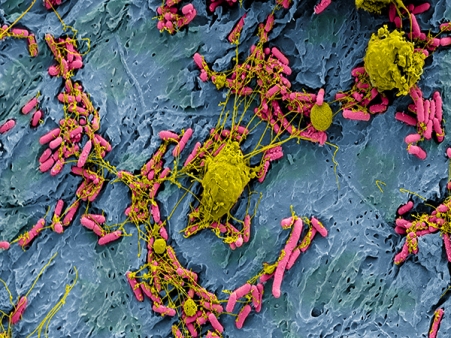05/25/2017 09:00 AM EDT

For patients who’ve succeeded in knocking out a bad urinary tract infection (UTI) with antibiotic treatment, it’s frustrating to have that uncomfortable burning sensation flare back up. Researchers are hopeful that this striking work of science and art can help them better understand why severe UTIs leave people at greater risk of subsequent infection, as […]
Snapshots of Life: Fighting Urinary Tract Infections

Source: Valerie O’Brien, Matthew Joens, Scott J. Hultgren, James A.J. Fitzpatrick, Washington University, St. Louis
For patients who’ve succeeded in knocking out a bad urinary tract infection (UTI) with antibiotic treatment, it’s frustrating to have that uncomfortable burning sensation flare back up. Researchers are hopeful that this striking work of science and art can help them better understand why severe UTIs leave people at greater risk of subsequent infection, as well as find ways to stop the vicious cycle.
Here you see the bladder (blue) of a laboratory mouse that was re-infected 24 hours earlier with the bacterium Escherichia coli (pink), a common cause of UTIs. White blood cells (yellow) reach out with what appear to be stringy extracellular traps to immobilize and kill the bacteria.
Valerie O’Brien, a graduate student in Scott Hultgren’s lab at Washington University, St. Louis, snapped this battle of microbes and white blood cells using a scanning electron microscope and then colorized it to draw out the striking details. It was one of the winners in the Federation of American Societies for Experimental Biology’s 2016 BioArt competition.
As reported last year in Nature Microbiology, O’Brien and her colleagues have evidence that severe UTIs leave a lasting imprint on bladder tissue [1]. That includes structural changes to the bladder wall and modifications in the gene activity of the cells that line its surface. The researchers suspect that a recurrent infection “hotwires” the bladder to rev up production of the enzyme Cox2 and enter an inflammatory state that makes living conditions even more hospitable for bacteria to grow and flourish. This suggests that recurrent UTIs might be treated more effectively with drugs that control inflammation. In fact, the researchers already have preliminary evidence that Cox2 inhibitors used to treat arthritis pain and other conditions might do the job.
The Hultgren lab is also exploring new ways to treat or prevent recurrent UTIs using chemical compounds and peptides designed to prevent bacteria from sticking to the bladder wall and infecting cells. As more bacteria grow resistant to existing antibiotic drugs, this new line of investigation raises hope that it might one day be possible to knock out UTIs out for good, maybe even with no antibiotics required.
Reference:
[1] A mucosal imprint left by prior Escherichia coli bladder infection sensitizes to recurrent disease. O’Brien VP, Hannan TJ, Yu L, Livny J, Roberson ED, Schwartz DJ, Souza S, Mendelsohn CL, Colonna M, Lewis AL, Hultgren SJ. Nat Microbiol. 2016 Oct 31;2:16196.
Links:
Bladder Infection in Adults (National Institute of Diabetes and Digestive and Kidney Diseases/NIH)
Antimicrobial (Drug) Resistance (National Institute of Allergy and Infectious Diseases/NIH)
Hultgren Lab (Washington University in St. Louis, MO)
BioArt (Federation of American Societies for Experimental Biology, Bethesda, MD)
NIH Support: National Institute of Diabetes and Digestive and Kidney Diseases; National Institute of Neurological Disorders and Stroke; and Office of Research on Women’s Health; National Institute of Allergy and Infectious Diseases; National Institute of Arthritis and Musculoskeletal and Skin Diseases; National Institute on Deafness and Other Communication Disorders






















.png)











No hay comentarios:
Publicar un comentario